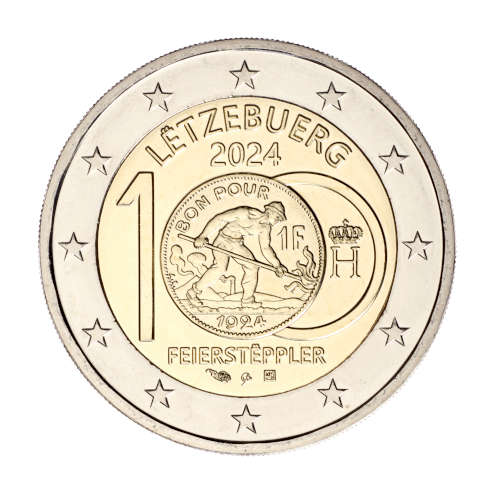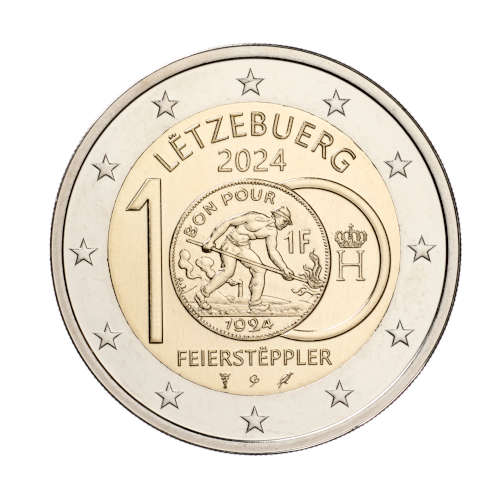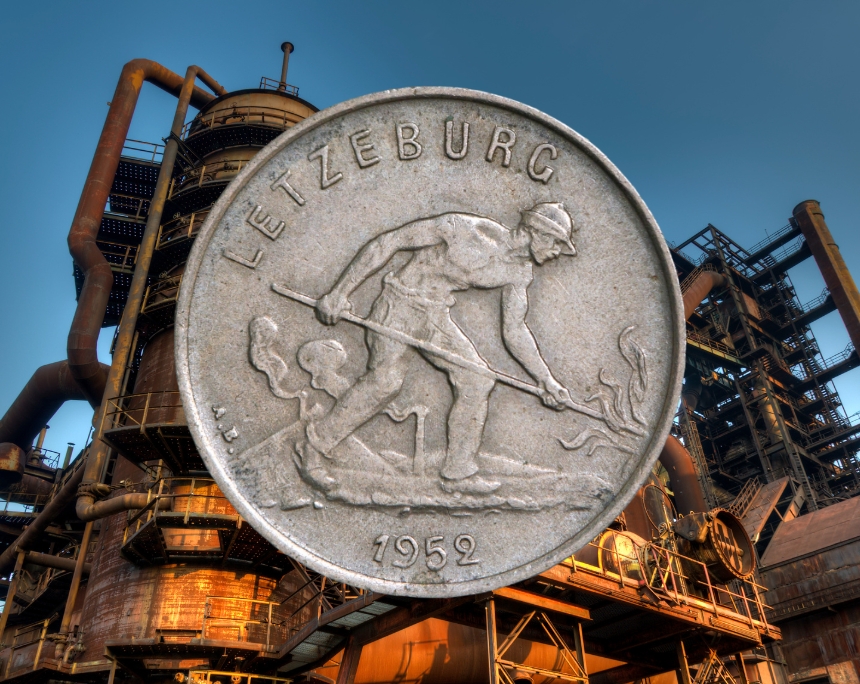A Coin on a Coin: Luxembourg to Resurrect the “Feierstëppler”
by Sebastian Wieschowski, translated by Maike Meßmann
Today, the Grand Duchy of Luxembourg is mainly known as a centre of the finance industry, as the seat of numerous European institutions and the correspondingly multi-cultural atmosphere, and for its picturesque nature and landscape. Many historic sites attract tourists, including castles and medieval city centres. Luxembourg City, the country’s capital, is a UNESCO World Heritage Site known for its well-preserved fortress. What is readily forgotten is the past significance of the steel industry for the small country, which is located between Germany, Belgium and France: the region had rich iron ore deposits and was an important producer of steel and iron. This industry was one of the major drivers of Luxembourg’s economy and played a crucial part in the country’s growth and industrialisation process.
Content
In Circulation from 1924 until 1981: Luxembourg’s Coin of a Century
The importance that the steel industry once had in Luxembourg can be seen from a 2-euro commemorative coin that is currently being issued by the Banque Centrale du Luxembourg and pays tribute to another Luxembourg coin. The unwieldy title of this 2-euro coin is: “100th anniversary of the Grand Ducal decree on the issue of the ‘Feierstëppler’”.
The latter were 1-franc coins, minted between 1924 and 1935 as well as between 1952 and 1964. They depict the so-called “Feierstëppler” at work, in the background blast furnaces and above the name of the country in Luxembourgish. During the first minting period, a total of 4 million coins entered circulation featuring the years 1924, 1928 and 1935. During the second period from 1952 until 1964, seven years with mintage figures between one and five million specimens per year were produced.
Literally translated, “Feierstëppler” refers to a person who pokes around in the fire. When looking at the depiction, we cannot even imagine how physically demanding this work is. In English, we would refer to this type of steelworker as a “puddler”. Puddling is the process of heating iron or steel in a puddling furnace and then stirring (or poking) the metal with a tool, often a hammer. In this way, the metal was cleaned and the process resulted in a homogeneous block of bar iron. The puddler played an important role in transforming the metal, preparing it for the next production steps.

Circulation issue: with only 120,000 specimens, the coin with the unwieldy title of “100th anniversary of the Grand Ducal decree on the issue of the ‘Feierstëppler’” is among this year’s rarities in the field of 2-euro commemorative coins. Photo: BCL
From Steelworker to Occasional Photo Model
The fact that a monarchy in the European interwar period and again after the Second World War, of all places, chose to put a scantily clad steelworker on its circulation coins, can certainly be understood as a form of marketing Luxembourg and promoting its location given the historical context: In 1911, the steel group “ARBED” was founded as a merger of the steelworks of Burbach (now a part of Saarbrücken, Germany), Eich (a suburb of Luxembourg City) and Dudelange (in the south of the country). At the time, ARBED was among the ten largest steel groups in the world, and Luxembourg produced more steel per capita than any other country on the planet; overall, the Grand Duchy ranked sixth in the world. In 1921, Luxembourg joined an economic union with Belgium and, after leaving the German Customs Union, quickly made a name for itself as a competitive steel producer in the global market. Therefore, it was a logical step to depict a symbol of the steel industry on Luxembourg coinage. The same held true during the second minting period starting in 1952, when the European Coal and Steel Community (ECSC) was founded and Luxembourg became the smallest member state at a table with Belgium, the Federal Republic of Germany, France, Italy and the Netherlands.
While the “Feierstëppler” is mainly known among elder citizens of Luxembourg, who remember the time of the Luxembourg franc, the people behind the coin quickly fell into oblivion: Auguste Trémont, a Luxembourg artist and sculptor, is said to have been so impressed by the strong body of the steelworker Mathias Gaasch that he hired him as a model. According to an article published on 2 March 2002 in “Luxemburger Wort”, Trémont was born on New Year’s Eve of 1892, studied in Paris but had to end his academic career and return home due to the First World War. According to the article, he was then commissioned by the “Aciérie de Dudelange” to capture scenes of work in the steelworks of Dudelange in paintings. This is where he met Mathias Gaasch. At the time, it was not envisaged to use the motif as a coin design, this work was later done by the Belgian artist Armand Bonnetain. Mathias Gaasch died in 1939 at the age of 67.

A relief issue: the special version with raised details of the motif will be exclusively sold in the form of coin cards. Photo: BCL
Although the coins with the “Feierstëppler” were withdrawn from circulation in 1991, the legend lived on: on 25 October 2002, a sculpture by Yvette Gastauer-Claire (who also created the designs for Luxembourg euro commemorative coins) with the title “De Feierstëppler” was unveiled in front of the Luxembourg central bank in the country’s capital. The sculpture is reminiscent of the Luxembourg franc and the steel industry – both are considered to have brought prosperity to the Grand Duchy. What is striking is the fact that the sculpture does not have a head but oversized hands. When it was unveiled, the artist explained that the large hands recur in all her sculptures due to their strong effect.

An issue with photo: as last year, collectors have quite a lot on their plate if they want to purchase all versions of Luxembourg commemorative coins. This special issue will only be issued as a coin set and features a latent image. Photo: BCL
Italian Authorship and a Focus on Special Effects
The 2-euro commemorative coins dedicated to the “Feierstëppler” in 2024 were created by the Italian artist Chiara Principe: “I found it beautiful and above all very significant that an European country wanted to dedicate a euro coin, and not a simple commemorative collector’s coin, to the celebration of the anniversary of a historic coin, symbolizing an important phase of the country. I was expressly asked to depict the entire Feiersteppler coin inside the 2 euro. I smiled thinking that the author, the Belgian Armand Bonnetain, certainly would never have imagined a hundred years later that he would find his coin on the face of a European currency, and – somehow – once again in the hands of all.” In the end, among the various design proposals, Luxembourg opted for a very simple, clear and direct composition, which plays with the number 100 of the anniversary. “It was truly an honour to sign this important coin and to be able to pay homage to such a beautiful numismatic work as the one created by Bonnetain.”
According to current plans, four different versions of the coin will be minted:
- The normal version with a mintage figure of 120,000 specimens was produced by the Monnaie de Paris. Therefore, these coins show the mint master’s mark of Joaquin Jimenez.
- De Koninklijke Nederlandse Munt will create the versions for coin cards with a special relief and a mintage figure of 7,500 pieces.
- Utrecht will also mint the special version for the coin sets of 2024. These pieces are highly unusual due to the latent image at a low mintage figure of 2,500 pieces. In the previous year, coin sets had originally been issued at around 40 euros – but due to this special feature, their value jumped to 150 to 200 euros.
- Later, special Proof issues will be launched, which will be included in a Proof coin set as well as a Proof collection. The total mintage figure of the Proof coins has not been made public yet, but is probably 3,500 pieces.








